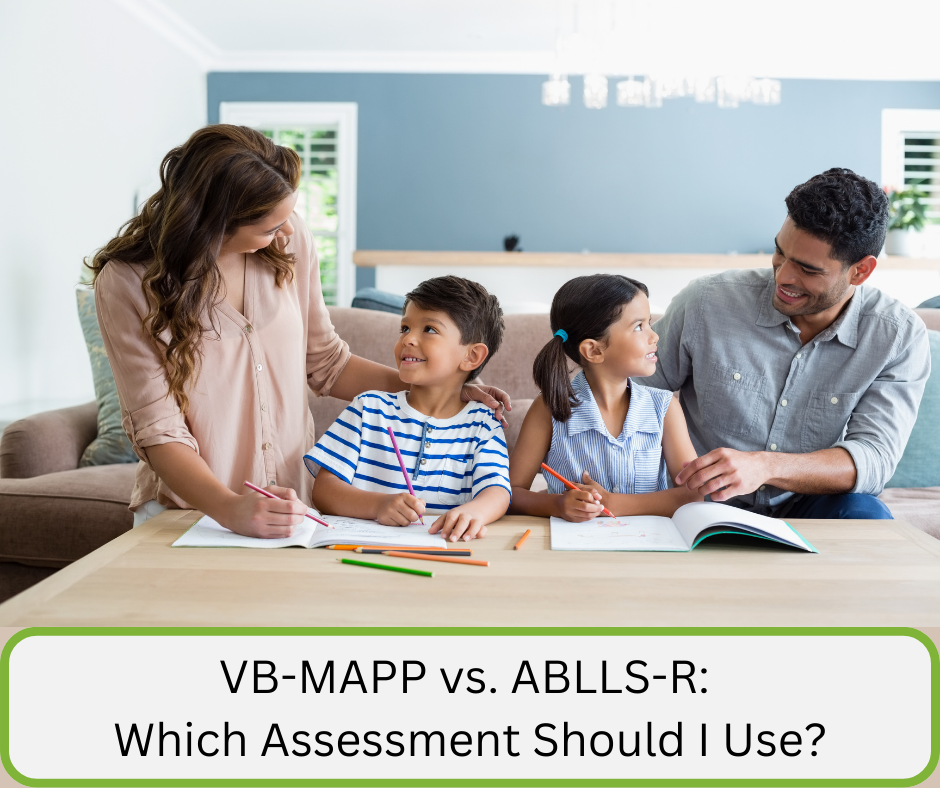
By Sam Blanco, BCBA
Assessment is the cornerstone of creating appropriate and effective interventions. Two common assessments used for youngsters with autism are the Assessment of Basic Language and Learning Skills-Revised (ABLLS-R) and the Verbal Behavior – Milestones Assessment and Placement Program (VB-MAPP). You’ve likely heard of both the ABLLS-R and the VB-MAPP. While these two assessments are similar in many ways, there are also some big differences that might make one more appropriate for you than the other.
ABLLS-R
The ABLLS-R is made up of two components: the ABLLS™-R Protocol and the ABLLS™-R Guide. The protocol is comprised of a skill-tracking system, assessing items ranging from listening and language skills to academic and ADL skills. The scoring system is simple, in that each specific skill is broken down into 2-4 levels. You simply mark the level that matches your client’s current skill. The simple organization allows for you to easily track your learner’s progress.
It is important to recognize that the ABLLS-R is more than just the protocol. It also includes the ABLLS-R Guide, which provides instructions for scoring as well as strategies for using the information to develop appropriate goals. Over the years, I have seen many practitioners simply using the protocol without referring to the guide. This is an error that should be corrected, as the guide is a useful resource for parents, teachers, and practitioners. Finally, the ABLLS-R assessed skills that typically develop between approximately ages 2-6.
VB-MAPP
The VB-MAPP is composed of five components.
The Milestones Assessment is comprised of 170 measurable milestones, all based in B.F. Skinner’s analysis of verbal behavior. It focuses primarily on language and social skills, but does include some skills related to academics.
The Barriers Assessment provides a way to assess and measure common barriers to learning experienced by children with language delays. These include barriers such as prompt dependence, impaired social skills, and failure to generalize.
The Transition Assessment provides a way to assess and measure progress towards the child’s ability to move to a less restrictive environment. This portion of the VB-MAPP includes items such as the rate of acquisition for new skills, adaptability to change, and ability to learn from the natural environment.
The fourth component of the VB-MAPP is the Task Analysis and Supporting Skills. This portion goes hand-in-hand with the Milestones Assessment. It is comprised of hundreds of skills that are often directly related to the milestones. It shows the skills that should be taught prior to each milestone and can provide additional information into the child’s current skill level.
The final portion is the VB-MAPP Placement and IEP Goals. This is an in-depth guide for developing IEP goals and identifying interventions based on the results of the other portions of the assessments. As with the ABLLS-R, I’ve seen many practitioners utilizing the VB-MAPP without referring to the Placement and IEP Goals in the VB-MAPP Guide. This is an error that should be corrected to best use the assessment. The VB-MAPP assesses language skills that typically develop by age 48 months.
VB-MAPP or ABLLS-R?
It is valuable to receive training in both of these assessments. They are important tools for assessment, especially if you are working with young children.
No matter what assessment you choose, we’ve got you covered! Head to our website and check out our full line of ABLLS-R and VB-MAPP supports, including our exclusive full assessment kits!
About The Author
Sam is an ABA provider for school-aged students in Brooklyn, New York. Working in education for over 15 years with students with Autism Spectrum Disorders and other developmental delays, Sam utilizes strategies for achieving a multitude of academic, behavior, and social goals. She is also an assistant professor in the ABA program at The Sage Colleges and the Senior Clinical Strategist at Encore Support Services. You can read more of Sam’s posts for Different Roads To Learning when you click here!
